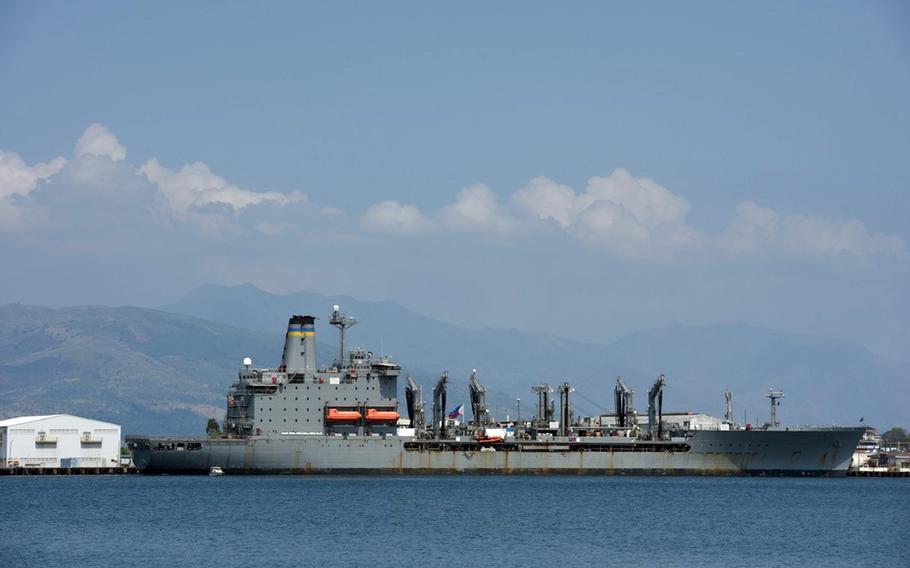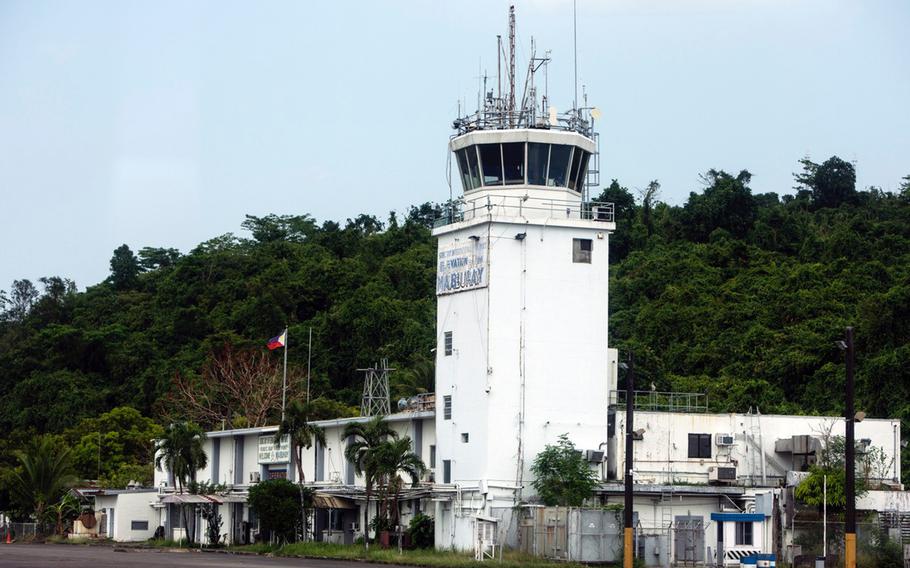
A U.S. Navy replenishment oiler, the USNS Big Horn, docks in Subic Bay while participating in Balikatan training in the Philippines, April 23, 2023. (Jonathan Snyder/Stars and Stripes)
American investors plan to develop facilities at a former U.S. naval base in the Philippines that could include the installation’s airport, according to a Philippine government news outlet.
Cerberus Capital Management, a New York-based private equity firm, took control of a large shipyard in Subic Bay last year. Eight hundred Philippine navy sailors are now stationed in part of the installation, the government-run Philippine News Agency reported Friday.
Cerberus executives, led by chairman and former U.S. Vice President Dan Quayle, discussed their investment plans during a Friday meeting with Philippine President Ferdinand Marcos in Malacañang, the Manila Bulletin newspaper reported Sunday.
“We’re all very excited about this project and … we have always tried to find a way to regain our position in the shipbuilding,” Marcos said during the meeting, according to the newspaper.
Cerberus did not immediately respond to questions emailed after hours Sunday in New York about the investment plans.
A spokesman for Marcos’ office, Chelly Garafil, told the Philippine News Agency on Friday that Cerberus “sees value” in improving the former Cubi Point naval air station at Subic to serve as a logistics and cargo hub.
U.S. Air Force AC-130J Ghostrider gunships, MC-130J Commando II airlifters, CV-22 Osprey tiltrotors and MQ-9 Reaper drones operated from Cubi Point during last month’s Balikatan drills involving more than 17,000 U.S. and Filipino troops.
Once a formidable Navy installation, Subic Bay has changed since U.S. forces departed in 1992. Subic Bay Metropolitan Corp., a government organization that runs the facility, is looking for ways to make money in the civilian sector.
South Korean shipbuilder Hyundai has expressed interest in two drydocks at Subic for shipbuilding and could move to the facility by year’s end. That project would create 5,000 to 15,000 jobs, according to the Philippine News Agency.
Cerberus subsidiary Subcomm, which builds and installs submarine cables, will begin operating from Subic Bay in August, Garafil said, according to the news agency.
Cerberus is also eyeing investments in the Philippines’ semiconductor and energy sectors, he said.
The mention of semiconductors and undersea cables suggests that the Philippines could become a terminus for cables in the Western Pacific and a backup to the Taiwanese semiconductor industry in the event of conflict or threat, according to Paul Buchanan, a New Zealand-based U.S. security expert.

The control tower at the former home of Naval Air Station Cubi Point, Philippines, is pictured on April 23, 2023. (Jonathan Snyder/Stars and Stripes)
The U.S. Navy could use improved facilities at Subic Bay for logistics, repairs and replenishment, Buchanan said in an email Monday.
“The participation of civilian enterprises gives good economic cover to whatever military purpose might be served by the expanded facilities,” he said.
The Subic Bay investments are a win for both parties, according to Patricio Abinales, a Philippines expert at the University of Hawaii.
“Cerberus will be able to fill the gap indeed and on the cheap while the Philippines may be able to avail (be it to buy, lease, etc.) of some of the ships constructed in this rehabilitated shipyard to project a more robust presence in the South China Sea,” he said in an email Monday.
The limited U.S. industrial capacity in shipyards is well known, Leland Bettis, director of the Guam-based Pacific Center for Island Security research institute, wrote in an email the same day.
“This contributes to the current (U.S. Navy) fleet maintenance backlogs as well as caps on the number of new vessels than can realistically be planned for delivery,” he said. “If political issues in the Philippines can be resolved, Navy work at U.S.-owned facilities in Subic has to be an attractive consideration.”